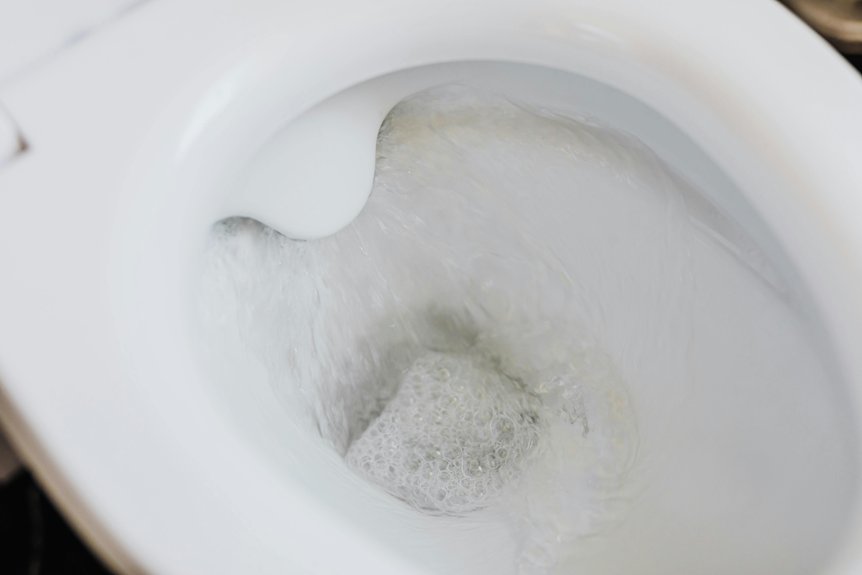When you flush the toilet, a fascinating series of events unfolds. You press the handle, and water rushes from the tank into the bowl, creating a powerful siphon that pulls waste away. But that’s just the beginning. What happens next as the waste travels through your plumbing system? Understanding this process reveals the engineering behind a common household fixture and its impact on sanitation. Let’s explore the intricacies that follow that simple action.
The Anatomy of a Toilet
When you take a closer look at a toilet, you’ll find it’s more than just a porcelain throne. It’s a complex system designed for comfort and efficiency.
At the basic level, it consists of the tank, bowl, and flushing mechanism. The tank holds water, while the bowl is where you sit. Inside the tank, you’ll discover the float, fill valve, and flush valve, all working together to manage water levels.
When you flush, the water rushes from the tank into the bowl, creating a whirlpool effect that helps carry waste away. Additionally, the toilet trap prevents odors from escaping into your bathroom.
Understanding these components can help you troubleshoot common issues and maintain your toilet effectively.
How Flushing Works: The Mechanics
Flushing a toilet might seem like a simple task, but the mechanics behind it are fascinating and efficient.
When you press the flush handle, it lifts a flapper valve at the bottom of the tank, releasing water into the bowl. This water rushes in, creating a siphoning effect that pulls waste through the trap and into the drain.
The tank then refills through a supply line, thanks to the float mechanism that controls the water level. This cycle repeats every time you flush, ensuring everything is disposed of properly.
You mightn’t think about it, but this seamless process relies on gravity, water pressure, and clever design, making your bathroom experience both simple and effective.
The Journey Through Your Plumbing System
After you flush, the journey of waste begins as it travels through your plumbing system, navigating a complex network of pipes and fixtures.
The water rushes down the toilet’s trap and into the drain line, where gravity plays a crucial role. As the waste moves through the pipes, it encounters bends and junctions, designed to prevent clogs and ensure smooth flow.
Your home’s plumbing system is equipped with vents that help maintain pressure and allow sewer gases to escape, keeping your environment safe.
If your plumbing’s functioning well, you’ll hardly notice this journey. However, blockages can occur, so it’s essential to be mindful of what you flush to keep everything flowing smoothly and prevent costly repairs down the line.
Wastewater Treatment: The Next Stop
Once the wastewater leaves your home, it embarks on a journey to the treatment facility, where it undergoes a meticulous process to ensure it’s safe for the environment.
At the facility, the wastewater is first screened to remove large debris. Next, it flows into sedimentation tanks, allowing solid materials to settle at the bottom. Meanwhile, microorganisms work to break down organic matter.
After this biological treatment, the water undergoes filtration and disinfection to eliminate remaining pathogens. This multi-step process ensures that the treated water meets safety standards before it’s released into local water bodies or reused.
Understanding this journey helps you appreciate the importance of proper waste disposal and the role you play in protecting our water systems.
The Role of Water Treatment Facilities
While you mightn’t think about it when you flush, water treatment facilities play a crucial role in safeguarding our environment and public health.
Once you flush, your wastewater travels to these facilities, where it undergoes a series of complex processes. First, large solids are removed through screening. Then, bacteria break down organic matter in aeration tanks. This treatment reduces harmful pathogens, making the water safer for the environment.
After filtering and disinfecting, treated water is often released into rivers or lakes, completing the cycle. By understanding this process, you can appreciate the vital work these facilities do.
Environmental Impact of Waste Disposal
When you flush the toilet, you mightn’t realize the broader environmental impact of waste disposal. Every time you pull that lever, human waste, chemicals, and excess water flow into the system, leading to significant ecological consequences.
Wastewater treatment plants work hard to process this waste, but they’re often overwhelmed by pollutants. Overflowing systems can leak contaminants into local waterways, harming aquatic life and disrupting ecosystems.
Moreover, the energy used in treatment processes contributes to greenhouse gas emissions, further impacting climate change.
Innovations in Sanitation Technology
As you consider the future of sanitation, innovative technologies are transforming how we manage waste and conserve resources.
Smart toilets equipped with sensors can detect clogs and alert you before they become major issues. Composting toilets, which turn waste into fertilizer, offer eco-friendly alternatives for areas without plumbing.
Moreover, waterless urinals use special materials to minimize water consumption, making them ideal for commercial spaces. Advanced wastewater treatment systems now recycle sewage into clean water, reducing environmental impact.
Additionally, mobile apps allow you to monitor your water usage and waste levels, promoting responsible habits.
With these advancements, you’re not just flushing away waste; you’re playing a part in a more sustainable future.
The Importance of Proper Maintenance
Proper maintenance of your toilet isn’t just about keeping it clean; it’s essential for ensuring its longevity and efficient operation.
Regularly checking for leaks and clogs can save you from costly repairs later. Make it a habit to inspect the flapper valve and refill tube, as these components can wear out over time.
Cleaning the toilet bowl with appropriate cleaners prevents stains and buildup, promoting better hygiene. Don’t forget to tighten any loose bolts and ensure the toilet isn’t wobbling, which can lead to cracks.
Additionally, keep an eye on the water level in the tank; improper levels can affect flushing efficiency.
Global Perspectives on Toilet Use and Sanitation
Understanding how toilets operate and the importance of maintenance brings us to a broader issue: global perspectives on toilet use and sanitation.
Around the world, access to clean and safe toilets varies significantly. In some countries, modern facilities are the norm, while others still rely on basic pit latrines.
You might be surprised to learn that nearly 4.2 billion people lack access to safely managed sanitation. This lack leads to health risks, environmental pollution, and social stigmas.
Educating yourself about these disparities can inspire change. By supporting initiatives that promote sanitation, you can help improve lives globally.
Conclusion
Next time you flush, remember the complex journey your waste takes and the engineering that makes it all possible. From the mechanics of your toilet to the treatment facilities that handle wastewater, each step plays a crucial role in maintaining a clean environment. By understanding this process, you can appreciate the importance of proper maintenance and innovations in sanitation. So, let’s stay informed and make conscious choices about our water use and waste disposal for a healthier planet.


